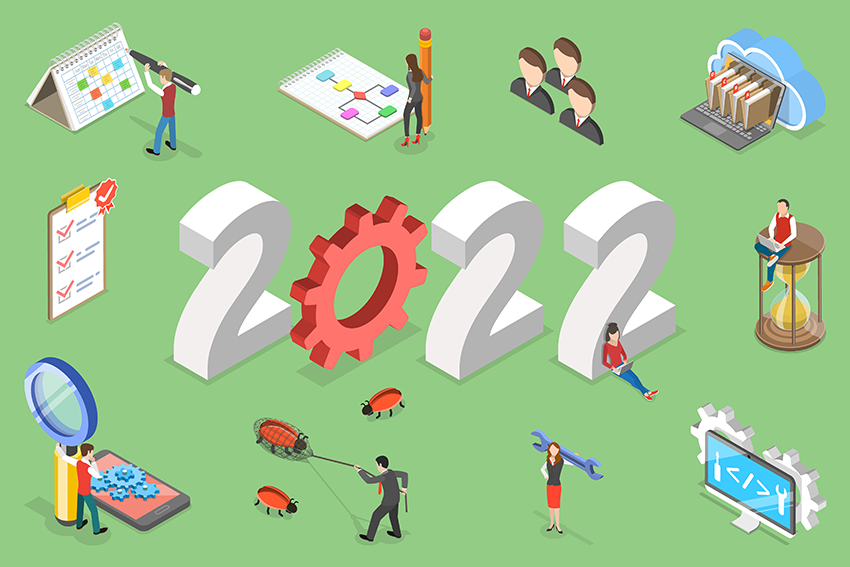Given the pace that technology continues to advance, businesses must choose the right approaches to be successful. Two of those approaches are the DevOps and DevSecOps disciplines. For CTOs planning their next move and developers wondering what technologies they need to embrace, we’ve compiled a list of the top trends set to dominate in 2022.
- Growing Adoption of GitOps
- Increasing Demand for Infrastructure as Code (IaC)
- Greater Kubernetes Adoption
- Serverless Architecture
- Rise of CloudOps
- Application Performance Monitoring (APM) Software
- Greater Focus on Privacy and Security
- AI, ML and Automation Influence On DevSecOps
- Supply Chain Attacks
- Integrated Security Measures in Testing
- Inclusion of Content Management Systems In the DevOps Pipeline
Growing Adoption of GitOps
The developer experience is a critical component of any advancement in technology and GitOps is a concept built around that experience. Using the version control system that Git provides, GitOps enables developers to manage infrastructure and application configurations.
Similar to the best practices found in DevOps, GitOps also utilizes code review and CI/CD pipelines to great effect. Teams can automate the infrastructure provisioning process, while keeping all files and development code in a Git repository. But why will this be a growing trend in 2022? Jason McMahon, Digital Strategist at Bambrick explains:
“It decreases downtime, making deployments more dependable and faster. GitOps teams may apply a similar concept to server infrastructure, apps, and even Kubernetes clusters. Given the complexity of multi-cloud, hybrid, and edge app deployments, leading players such as Microsoft Azure and Amazon AWS have expressed support for this paradigm.”
Getting started with GitOps depends on whether or not your development team already uses Git as its configuration management tool. If it does, then you simply need to add infrastructure as code to the Git repository and then configure the CI/CD pipeline to include infrastructure repo as part of the delivery pipeline. For those not already using Git then the initial starting point includes choosing a Git repository such as GitHub or GitLab.
Increasing Demand for Infrastructure as Code
As the name suggests, infrastructure as code (IaC) is the concept of managing and provisioning infrastructure through code rather than through manual processes. It enables developers to provision the same environment each time and helps configuration management, meaning that teams can avoid ad-hoc configuration changes. David Wurst, CEO at Webcitz provides some more insight,
“Infrastructure as code is more than just automation and is becoming increasingly important in DevOps. It provides continuity by automatically provisioning and configuring all environments with no human mistake. Some of the most important advantages of IaC are simpler cloud-native adoption, increasingly ephemeral architecture, traceability, consistency in delivering identical configurations, and improved efficiency throughout the whole software development cycle. With Infrastructure as code, you can even revert to the 'last configuration that worked.' As more teams realize the benefits of IaC, it will remain the standard and major DevOps feature in 2022 and beyond.”
Continued Kubernetes Adoption
Already the standard for container orchestration, Kubernetes is a key component of any cloud strategy. Not only does it support enterprises that want to embrace being cloud-native, it also enables greater DevOps adoption throughout the enterprise. Kubernetes can provide greater portability and flexibility, as well as scalability and resource utilization. According to Eric McGee, Senior Network Engineer at TRGDatacenters:
“The biggest trend in DevOps that is set to transform the industry in 2022 is the continued adoption of Kubernetes, the open-source platform that allows for the management of containerized workloads, enabling automated software app deployment, as well as the real time sharing of apps and software between the software development team and the IT operations team.”
The benefits of Kubernetes are clear to see and the hopes of receiving these benefits should drive further adoption, McGee continues:
“Adoption of Kubernetes also allows developers to use AI and ML tools to analyze, forecast, remedy, and automate software development work processes, enhancing their efficiency and functionality. Productivity is significantly enhanced thanks to the adoption of Kubernetes workflow, and 2022 will see more tech companies adopt this framework in the development and scaling of their software apps.”
Serverless Architecture
The need to manage architecture can place an additional burden on the shoulders of development teams who would be rather focused on building and launching new applications. Serverless architecture can provide a means for organizations to build applications without having to manage infrastructure and the benefits extend to DevOps. Vinod Satapara, Technical Director at iFour Technolab, believes that this can lead to an important trend in 2022 that improves DevOps implementation and expenditure:
“DevOps can be reached to a higher level with serverless architecture. However, in reality, it is not free from a server, but there's a 3rd party cloud service that deals with the whole architecture. This exceptional architecture permits developers to focus on the "Application Part". FaaS and BaaS are the two critical parts of serverless design. By executing serverless design, you can reduce expenses, save time and guarantee a strong progression of work.”
Rise of CloudOps
CloudOps, an extension of DevOps, is an approach to managing cloud-hosted applications and their underlying infrastructures. CloudOps is about formalizing best practices and procedures enabling applications to function properly in the cloud and consume cloud resources cost-effectively. In order to deploy more cloud-based applications and benefit from digital transformation, enterprises will need to embrace CloudOps by hiring and training developers with CloudOps skills as well as introducing more tools to help with its implementation. As more enterprises choose the cloud, CloudOps will become a necessity, points out Boris Shiklo, CTO at ScienceSoft.
“More and more companies among our clients decide to move their workloads to cloud platforms to achieve greater cost-efficiency and agility. The success of such endeavors depends on having an effective CloudOps strategy. To implement the CloudOps approach, you’ll need a dedicated team proficient in cloud governance and capacity planning tools, security, performance monitoring, and more.”
Usage of Application Performance Monitoring Software
Monitoring and observability are two important pieces of DevOps culture. Application performance monitoring (APM) in particular, improves observability, and helps businesses improve user experience by optimizing service performance and response times. Front-end monitoring aids in the observation of user interaction behavior and performance, while ADTD, which stands for application discovery, tracing, and diagnostics, examines the relationship between web and application servers, infrastructure, and microservices.
Furthermore, analytics enabled by AIOps, helps detect patterns, anomalies, and causality across the software lifecycle. Given all of these benefits, expect more organizations to embrace APM software in 2022, according to Tim Parker, Director of Marketing at Syntax Integration:
“APM software is vital since it allows developers to receive immediate feedback during deployments. APM is critical for reducing Mean Time to Repair (MTTR) and increasing user experience. DevOps teams benefit from APM capabilities because they allow them better understand business processes, gain insight into company operations, and isolate and prioritize problems.”
Greater Focus on Privacy
As security becomes an even greater concern for organizations that implement DevOps, so too does the concept of privacy. Expect this trend to continue in 2022 as businesses move to ensure that their data from software applications is secured throughout the DevOps lifecycle. Christian Velitchkov, co-Founder of Twiz.io, explains that with these changes, businesses will need to rethink how they ensure the security of their software applications:
“Privacy is a matter of concern and needs to be addressed seriously. As a part of the trend, DevOps will need to rethink their ways of designing and writing their software. They will have to prioritize the safety and security of the users. Their focal goals would be understanding the security targets and protection required, having adequate cloud scanners, and infusing security codes.They will be focusing on cloud security since cloud computing is no longer a luxury but an everyday tool for most businesses these days.”
AI, ML and Automation Influence On DevSecOps
Machine Learning systems can handle and process enormous data with the help of automation, form reliable predictions, and deliver accurate analysis. Using these data, ML and AI-based systems can provide effective estimates that help to proceed with the next phase. AI can find unusual patterns and unknown malicious code of command and control for supply chain infections in the cloud. Expect companies to leverage these tools to aid in the implementation of DevSecOps and securing the DevOps lifecycle. Ajay Patel, Director at iFour Technolab, provides some insight into why this will be a trend in the coming year:
“Machine Language and Artificial Intelligence will be a great help to automate DevOps practices. The entire vision of development and technology utilization has transformed with the emergence of AI and ML. AI-based detection infused into the DevSecOps processes allows for defence against malicious code implants and attackers. The use of automation will be the best way to reduce the number of repetitive tasks and take human error out of the equation."
Preventing Supply Chain Attacks
Threats continue to grow in the area of software development and the latest threat to impact software application security are supply chain attacks. As a result, DevSecOps will increasingly focus on protecting against these threats says Lee McClendon, Chief Digital Officer at Tricentis:
“Securing the software supply chain will be a major area of focus for the DevSecOps community in 2022. The prevalence of supply chain attacks during the last twelve months and the resulting executive orders from the US government mandating integrity have caused software vendors and their customers to take notice of this threat. Customers will increasingly expect transparency into the processes, libraries and tools that are used to create the software that they allow into their trusted environments.”
Integrated Security Measures In Testing
One of the primary adjustments made to the DevOps pipeline has been the introduction of security into the DevOps cycle and the birth of DevSecOps. Expect DevSecOps adoption to continue to grow as Scott Hirsch, CTO and Co-founder of TalentMarketplace explains how integrated security testing will impact the future of DevOps:
“One DevOps trend that will be huge in 2022 is integrated security measures as part of the testing pipeline. Testing as part of a deployment pipeline is normal but usually unit testing and functional. A trend that is becoming more common is including security tests as part of the testing suite which can include things such as testing for injections and request forgeries.”
The growth of cloud computing has meant that new threats have emerged over the last few years, especially as we factor in the number of companies that underwent or are currently undergoing digital transformation and the number of SaaS applications available. Integrating security into testing comes as companies begin to shift their focus left of the DevOps cycle and attempt to find vulnerabilities before applications are deployed into production and made available to the public.
Inclusion of Content Management Systems In the DevOps Pipeline
Another area that will see growth in 2022 is the inclusion of content management processes and CMS tools into the DevOps cycle. Content applications are becoming more prevalent across the digital landscape and with the emergence of more and more channels for consumers. As companies work to build more content-driven applications to engage customers, partners, and employees, content authors and editors will need to work more seamlessly with developers.
These developers are already accustomed to the DevOps cycle for building software applications but currently many of these systems don’t include the CMS and content authoring/publishing workflows into the DevOps lifecycle. To break down the silos, DevContentOps will provide the cultural and technological shift that companies need to embrace. By adopting this approach, companies can enable collaboration between IT operations, developers and content authors to deliver modern digital experiences. As Russ Danner, VP of Products and Customer Success at CrafterCMS explains:
"Integrating content management authoring and publishing workflows more seamlessly into the content application development, testing, and release cycles results in huge productivity gains for our enterprise customers. DevOps and content authoring teams can work in parallel without interruption. DevContenOps eliminates traditional CMS development bottlenecks such as content freezes, long QA cycles, complicated syncing of content and code among environments, and more."
Get Ready for 2022 DevOps & DevSecOps Trends
DevOps isn’t just a buzzword, nor is every organization using it to its full potential just yet. The benefits of adopting the approach have been clear to see and digital companies aiming to get ahead should pay attention to these trends set to dominate in 2022. In addition, the growing inclusion of security and content into the DevOps cycles and the possibilities they could create are notable as they represent an evolution to the next stage of DevOps.

 Mike Vertal
Mike Vertal




